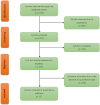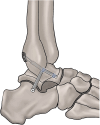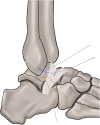All-inside arthroscopic procedures for chronic lateral ankle instability: evidence-based clinical practice guidelines
- PMID: 40183802
- PMCID: PMC11970022
- DOI: 10.1093/bmb/ldaf001
All-inside arthroscopic procedures for chronic lateral ankle instability: evidence-based clinical practice guidelines
Abstract
Background: All-inside arthroscopic procedures are now frequently employed to manage chronic lateral ankle instability (CLAI) with satisfactory functional outcomes. Currently, no evidence-based guidelines exist for all-inside arthroscopic procedures for CLAI. Many surgical decisions remain uncertain and challenging.
Sources of data: Published scientific literature in PubMed, MEDLINE, Web of Science, EMBASE, and Cochrane databases.
Areas of agreement: All-inside arthroscopic repair and reconstruction procedures are reliable treatments for CLAI.
Areas of controversy: The all-inside arthroscopic procedures for CLAI present significant challenges, particularly in the following aspects.
Growing points: Given the lack of guidelines for the all-inside arthroscopic procedures for CLAI, this evidence-based clinical practice guideline provides 11 recommendations to address the controversy.
Areas timely for developing research: In patients with CLAI undergoing all-inside arthroscopic procedures, comparative studies are urgently needed to establish the optimal timing for weight-bearing, as well as return to work and sports.
Keywords: arthroscopic management; chronic lateral ankle instability; guidelines.
© The Author(s) 2025. Published by Oxford University Press.
Conflict of interest statement
None declared.
Figures





Similar articles
-
Clinical practice guidelines for rehabilitation following surgical management of chronic lateral ankle instability: enhancing recovery based on available evidence.Br Med Bull. 2025 Apr 4;154(1):ldaf002. doi: 10.1093/bmb/ldaf002. Br Med Bull. 2025. PMID: 40350696
-
Comparison of arthroscopic and open Brostrom-Gould surgery for chronic ankle instability: a systematic review and meta-analysis.J Orthop Surg Res. 2023 Nov 14;18(1):866. doi: 10.1186/s13018-023-04292-5. J Orthop Surg Res. 2023. PMID: 37964306 Free PMC article.
-
Limited medial osteochondral lesions of the talus associated with chronic ankle instability do not impact the results of endoscopic modified Broström ligament repair.J Orthop Surg Res. 2022 Feb 3;17(1):69. doi: 10.1186/s13018-022-02968-y. J Orthop Surg Res. 2022. PMID: 35115041 Free PMC article.
-
All-inside arthroscopic modified Broström-Gould procedure for chronic lateral ankle instability with and without anterior talofibular ligament remnant repair produced similar functional results.Knee Surg Sports Traumatol Arthrosc. 2021 Aug;29(8):2453-2461. doi: 10.1007/s00167-020-06361-2. Epub 2020 Nov 18. Knee Surg Sports Traumatol Arthrosc. 2021. PMID: 33206208 Free PMC article.
-
Does arthroscopic repair show superiority over open repair of lateral ankle ligament for chronic lateral ankle instability: a systematic review and meta-analysis.J Orthop Surg Res. 2020 Aug 26;15(1):355. doi: 10.1186/s13018-020-01886-1. J Orthop Surg Res. 2020. PMID: 32843055 Free PMC article.
Cited by
-
Two portals are sufficient for all-inside arthroscopic isolate anterior talofibular ligament repair.Arch Orthop Trauma Surg. 2025 May 24;145(1):316. doi: 10.1007/s00402-025-05927-4. Arch Orthop Trauma Surg. 2025. PMID: 40413275 Free PMC article.
References
Publication types
MeSH terms
Grants and funding
LinkOut - more resources
Full Text Sources
Research Materials

